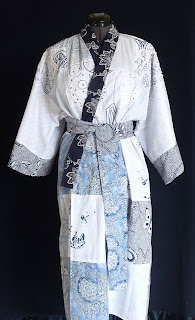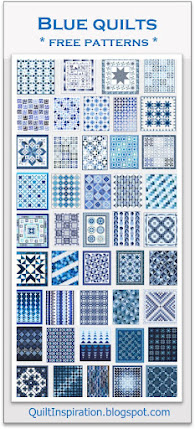In keeping with our Day of the Dead theme, we are featuring a quilt from artist Sandy Small Proudfoot. Sandy hails from the town of Mono, in the province of Ontario, Canada. She taught quiltmaking in Toronto for 10 years, during which time she was accepted into the very selective Ontario Art and Design University, where she earned a diploma. Her quilts have been juried into worldwide Mancuso quilt shows. As you can see below, she has a wonderful sense of style and perspective.
Many thanks to Sandy for her generosity in sharing her photos and descriptions with Quilt Inspiration!
Electronic Intrusion by Sandy Small Proudfoot ,Ontario, Canada.
Long-arm machine quilted by Mary Light, Ontario, Canada
What a creative way to emphasize a very important message! This design is extremely innovative and original, especially the way that the
dark cross exemplifies the screen of a cell phone with its colored
apps. Sandy has created an excellent sense of dimensionality, with the blue
background which looks like the heavens lit from behind the sky, and
the skeleton with its shroud looks very three-dimensional also. We
really like the brilliant use of contrasting colors to show the Flor de
Muertos, or the marigolds at the base of the cross, with the dancing
cadavers.
Sandy's quilt really caught our eye, because of its color, symmetry, and design elements. The deep blue background fabric which represents the heavens looks as if it has been lighted from behind, which enhances the bright orange and green buttons of the cellphones. We think her work is exceptional !
Sandy would also like to thank those quilt artists and designers who accepted her invitation to teach at the First Canadian Quilt Conference, which Virginia Avery later termed, a Symposium. Sandy says, " Without the impact of seeing the work of Jean Ray Laury, Beth and her then husband, Jeffery Gutcheon, Virginia and Michael James, I would not have been so inspired in realizing that a quilt was more than just two layers of cloth with batting in between, but that a quilt was also a form of art and design. It wasn’t something I’d related to before as I was a traditionalist in my teaching and making quilts. Jean, Jeffery and Virginia are honoured in the Quilters Hall of Fame now and although names that may not be familiar to quilters today, they were the forerunners of a very different style of design created on quilts during the early part of the nineteen-seventies and thereafter."
Image credits: Images are shown with permission of Sandy Small Proudfoot. All Rights Reserved.

















Thank you for featuring my Electronic Intrusion on your wonderfully informative website for quilters. And thank you, too, for mentioning how the work of the late Jean Ray Laury, Jeff Gutcheon, Virginia Avery and the very much alive Beth Gutcheon and Michael James inspired me to know that if I was ever to grow creatively with my designwork as a quiltmaker, it would require a formal visual art education, which I acquired in the years to come following Canada's First Canadian Quilt Conference (Symposium). For a quilter to enter the Ontario College of Art, now Art & Design University, may have been unheard of. When I applied, I did not know how to make a proper presentation of my quilts, which the first two instructors quickly deemed suitable for an Art College application. However, the third instructor, Mr. Claude Gidman, looked at my work, asked me what I wanted to learn at Art College, I replied 'Colour & Design' and he quickly arranged for me to be interviewed by the head of the Design Dept. the following week. However, his parting comment was, 'if she doesn't let you in, don't bother trying again' (to enter OCA). Years later I met Mr. Gidman, head of Industrial Design at the College and I thanked him for allowing me the opportunity to study visual art. Mind you, learning visual art is a long way from academia. It requires a whole new concept of thinking and seeing . However, I can recommend it to anyone who is seriously wanting to learn more about the concept and structure of design.
ReplyDeleteSincerely, Sandy Small Proudfoot, Canada.